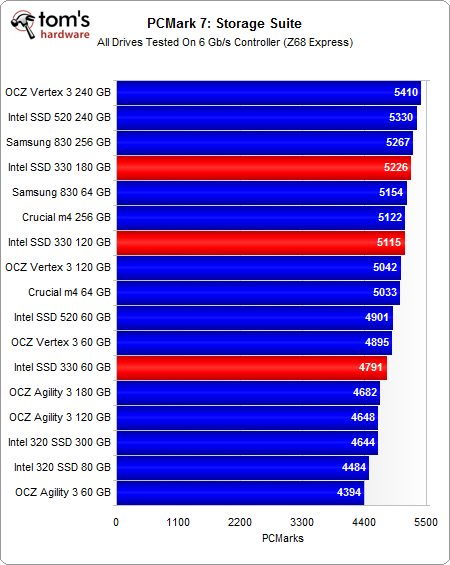Intel SSD 330 Review: 60, 120, And 180 GB Models Benchmarked
Benchmark Results: Storage Suite v1.0 And PCMark 7
Storage Bench v1.0 (Background Info)
Storage Bench v1.0 is our home-grown trace tool that replays the first two weeks of I/O activity on a desktop workstation. Because it includes several software installations, the trace incorporates quite a bit of sequentially-written compressible and incompressible information.
As Intel's specs indicated, the SSD 330 actually does perform slower than its SSD 520. Singling out the 120 GB models, it looks like the SSD 330 falls behind by about 13%. Still, that's pretty respectable. After all, OCZ's 120 GB Agility 3 is about 10% slower than the SSD 330.
By the time we get down to the 60 GB drives, the SSD 330 is even able to match OCZ's higher-end Vertex 3.
When you consider the field more completely, though, we see that the inclusion of incompressible data in our trace puts the SandForce-based drives at a marked disadvantage. Even Samsung's 64 GB 830 outperforms the 180 GB SSD 330.
PCMark 7
PCMark 7 puts more of an emphasis on compressible data, which is why the SandForce-based drives move up the chart. At any given capacity, Intel's SSD 330 typically trails the SSD 520 and outperforms OCZ's Agility 3.
Get Tom's Hardware's best news and in-depth reviews, straight to your inbox.
Current page: Benchmark Results: Storage Suite v1.0 And PCMark 7
Prev Page Benchmark Results: Incompressible Performance Next Page Power Consumption-
Au_equus I bought this samsung 830 256gb ssd for $390 five-six months agoReply
http://www.newegg.com/Product/Product.aspx?Item=N82E16820147164
now its $275 or $1.074/GB. Better price/stability/performance than those listed above. -
phamhlam au_equusI bought this samsung 830 256gb ssd for $390 five-six months agohttp://www.newegg.com/Product/Prod 6820147164now its $275 or $1.074/GB. Better price/stability/performance than those listed above.Reply
Crucial m4 128GB from Newegg and Amazon @ 124.99. That is less than $1/GB. -
One question, which didn't explained: what Intel SSD is better for SATA 3Gb/sec 320 or 330 series?Reply
-
blazorthon Intel should have used non-SandForce controllers. The Vertex 4 (with the new firmware) shows what Sandforce alternatives are capable of, I hope that Intel's next flagship series does something similarly spectacular without Sandforce. I think that Intel could have used the 330s as a stepping stone to get a controller (such as a Marvell controller) up to Vertex 4-like performance (or better) in more universal workloads than Sandforce for their next flagship series.Reply
On that note, why weren't the Vertex 4s included in this review with the other drives? -
blazorthon EoveinOne question, which didn't explained: what Intel SSD is better for SATA 3Gb/sec 320 or 330 series?Reply
I don't think that it makes much difference at SATA 3Gb/s, but the 330s are faster drives, so they might be marginally better. -
blazorthon chimera201When will the price of SSD come down to HDD level? That would be news.Reply
Probably at least not until a cheaper memory than Flash is used in SSDs, so maybe ten to twenty years, if we're lucky. -
EDVINASM Am not a mad scientist or anything so I have missed something but to me Intel SSD is as good as any others on the market. I wouldn't see any difference in real world scenario between 330 and 520 or Samsung 830 or even M4. Who cares? I don't anyway. Just get the drive that you trust and that has reasonable warranty (3 years +) and good support. Done.Reply -
blazorthon edvinasmAm not a mad scientist or anything so I have missed something but to me Intel SSD is as good as any others on the market. I wouldn't see any difference in real world scenario between 330 and 520 or Samsung 830 or even M4. Who cares? I don't anyway. Just get the drive that you trust and that has reasonable warranty (3 years +) and good support. Done.Reply
Whether or not a part that is faster for your workloads than others and is faster enough to make a difference depends on what you are doing. If I was doing a lot of storage heavy stuff, like constantly downloading and decompressing large archives, then an SSD that can deal with in-compressible data very well would provide very noticeable gains over any SandForce drive or any lower end non-Sandforce drives. -
EDVINASM blazorthonWhether or not a part that is faster for your workloads than others and is faster enough to make a difference depends on what you are doing. If I was doing a lot of storage heavy stuff, like constantly downloading and decompressing large archives, then an SSD that can deal with in-compressible data very well would provide very noticeable gains over any SandForce drive or any lower end non-Sandforce drives.Reply
Fair point. Mind you, if you do that much and it's that important hardly any of standard (consumer grade) SSDs would interest you. Unless you are talking of downloading software and games from questionable sites, then yes - cheap and fast is cheerful.

